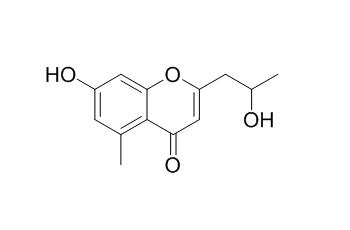dl-Aloesol
dl-Aloesol is a natural product from the secondary metabolites of endophytic fungus HCCB06030.
Inquire / Order:
manager@chemfaces.com
Technical Inquiries:
service@chemfaces.com
Tel:
+86-27-84237783
Fax:
+86-27-84254680
Address:
1 Building, No. 83, CheCheng Rd., Wuhan Economic and Technological Development Zone, Wuhan, Hubei 430056, PRC
Providing storage is as stated on the product vial and the vial is kept tightly sealed, the product can be stored for up to
24 months(2-8C).
Wherever possible, you should prepare and use solutions on the same day. However, if you need to make up stock solutions in advance, we recommend that you store the solution as aliquots in tightly sealed vials at -20C. Generally, these will be useable for up to two weeks. Before use, and prior to opening the vial we recommend that you allow your product to equilibrate to room temperature for at least 1 hour.
Need more advice on solubility, usage and handling? Please email to: service@chemfaces.com
The packaging of the product may have turned upside down during transportation, resulting in the natural compounds adhering to the neck or cap of the vial. take the vial out of its packaging and gently shake to let the compounds fall to the bottom of the vial. for liquid products, centrifuge at 200-500 RPM to gather the liquid at the bottom of the vial. try to avoid loss or contamination during handling.
Front Pharmacol.2021, 12:762829.
Chem Pharm Bull (Tokyo).2017, 65(9):826-832
Heliyon.2023, 9(11):e21944.
BMC Pharmacol Toxicol.2018, 19(1):5
Neurotox Res.2020, 38(1):163-174.
BMC Complement Altern Med.2018, 18(1):221
Antioxidants (Basel).2020, 9(2):E120
Nat Commun.2023, 14(1):5075.
Nutrients.2019, 12(1)
Industrial Food Engineering2015, 19(4):408-413
Related and Featured Products
Chem Pharm Bull (Tokyo). 1991 Mar;39(3):704-8.
Metabolism of aloesin and related compounds by human intestinal bacteria: a bacterial cleavage of the C-glucosyl bond and the subsequent reduction of the acetonyl side chain.[Pubmed:
2070451]
METHODS AND RESULTS:
By anaerobic incubation with a bacterial mixture from human feces, aloesin (aloeresin B; 1) was converted to 2-acetonyl-7-hydroxy-5-methylchromone (aloesone; 3) and dl-7-hydroxy-2-(2'-hydroxypropyl)-5-methylchromone (aloesol; 4a + 4b) through a cleavage of the C-glucosyl bond, followed by reduction of the acetonyl side chain. An analogous compound, aloeresin A (2), was converted to p-coumaric acid and aloesin (1), the latter being subsequently transformed to aloesone (3) and dl-Aloesol (4a + 4b). On the other hand, 7-O-methylated derivatives (7, 5a and 5b) of aloesin and of 8-C-glucosylaloesol were not cleaved to the corresponding aglycones, suggesting the importance of a free hydroxy group adjacent to the C-glucosyl group in the molecule for the bacterial cleavage of aloesin derivatives.
CONCLUSIONS:
This is the first report on the cleavage of the C-glycosyl bond of chromone C-glucosides by intestinal bacteria.



